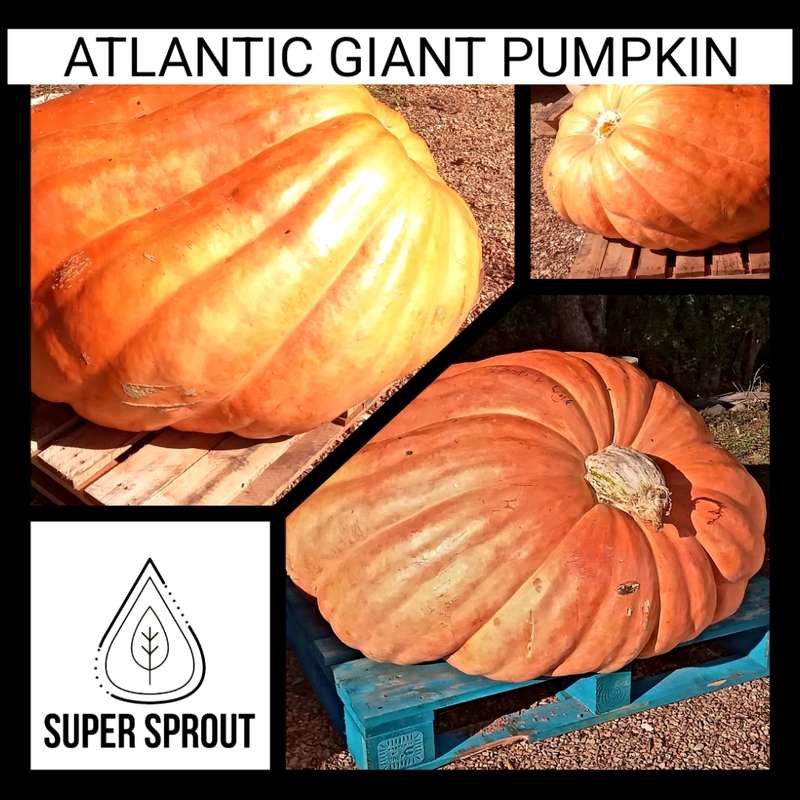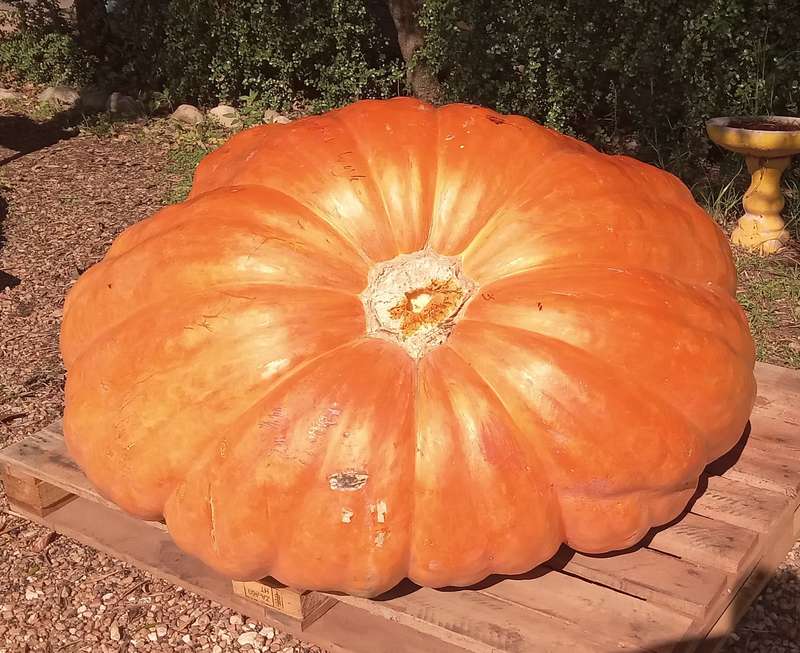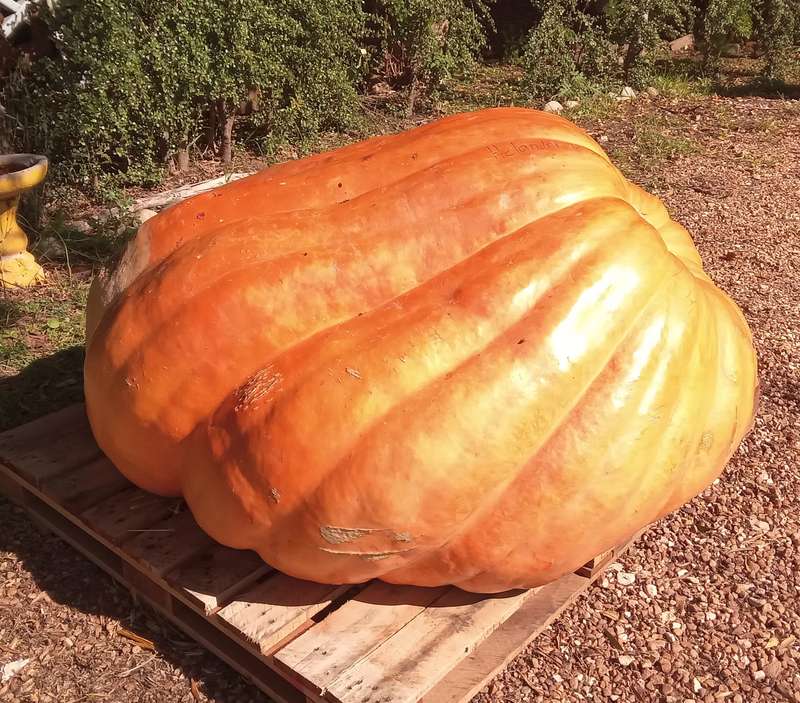Atlantic Giant pumpkin seeds hold the world record for giant pumpkins, and produce the largest fruit in the plant kingdom. Bred in eastern Canada by Howard Dill, Atlantic Giant can reach 1,000 lbs or more!
Site Selection and Planting
Growing space in the garden is important. Each plant should be allowed approximately 1,000 square feet. This area may sound quite large, but it is essential for vine growth. Pumpkins prefer long hours of sunlight, so select your garden site accordingly. Avoid shaded areas and select an area with good surface drainage. Proximity to a water source is important, also, as these pumpkins will require large amounts of water to reach maximum size.
Preparation of the site should start the fall before with incorporation of organic matter such as composted manures or leaf litter. The addition of organic matter (manure, compost) to the garden is important to establish good soil tilth. Some growers will plant a fall cover crop such as oats, annual rye, or clover to add organic matter to the soils.
Fertilizer and Lime
A soil test is recommended in the fall to address issues related to pH, and whether soil amendments such as lime and other macronutrients need applied prior to spring planting. Always apply lime and fertilizers based on soil test recommendations. Providing adequate nutrients throughout the growing season will insure healthy, vigorous vines, not to mention larger pumpkins.
In the spring, granular fertilizers should be applied as a broadcast application over the soil surface and incorporated into the soil 4 to 6 inches deep a few days ahead of setting out your transplants. Giant pumpkin vines require approximately 2 pounds nitrogen (N), 3 pounds phosphorous (P2O2) and 6 pounds potash (K2O) per 1,000 square feet of growing space.
A foliar feeding or fertigation program should be started after pollination and fruit set have occurred. There are several foliar fertilizers available. Follow label directions and continue application throughout the growing season.
Growing giant pumpkins requires an early start. Seeds should be sown individually and started indoors in 12-inch peat pots about the end of April. A well-balanced potting medium is recommended. Plants are ready for transplanting when the first true leaf is fully expanded. This is usually 10 to 14 days after seeding. Transplants can be protected from late spring frost using a floating row cover, cold frame, or small greenhouse.
Plastic mulches are very effective for controlling weeds. Plastic mulches also warm the soil and can maintain good soil moisture levels. The plastic can be installed when the soil is in good planting condition, any time from a few days to two to three weeks before planting. If you do not use plastic, pumpkins will benefit from organic mulches applied in the summer after the soil has warmed.
When summer mulching materials are used, such as straw, additional nitrogen is recommended. Mix 1 tablespoon of ammonium sulfate, calcium nitrate, or nitrate of soda per one bushel of mulch. Apply once or twice during the early growing season. A complete fertilizer that is high in nitrogen may be substituted for any of the above. Apply the fertilizer when the mulch is moist.
Herbicides are also available for weed control. However, only a trained and licensed applicator should apply these materials.
Windbreaks
Windbreaks are necessary to protect young plants from being "wind whipped" prior to becoming fully rooted. Windbreaks should be positioned on plants most susceptible to southwest winds until late June when side-runners are 3 to 4 feet long. The use of a snow fence and burlap can make an excellent windbreak. Covering the vines at each node with soil will help anchor vines down and promote secondary root development.
Insects and Diseases
The site where you plant should only be used once every three years to reduce the incidence of insect and disease pressure. Without following a regular pest scouting and management program for insects and diseases, your success rate for producing a giant pumpkin will be significantly reduced. An insect and disease control program must be initiated at transplanting.
Striped cucumber beetles can transmit bacterial wilt and aphids can vector viruses, so be aware of these early and late season pests. Prepare to manage them if they arrive in significant numbers. Once a bacterial or viral infection has occurred, there is no way to stop it. There are other pests like squash bug and squash vine borer that growers also need to monitor for throughout the season and be prepared to manage if necessary.
Powdery mildew is the disease every grower will see every year; the fungal colonies resemble powdered sugar sprinkled on both sides of the leaf. Bacterial diseases like angular leaf spot and bacterial leaf spot are favored by wet weather. Soil-borne diseases like Fusarium, Phytophthora, and Plectosporium are also favored by wet weather and unfortunately are not easily controlled using fungicides. When using fungicides, remember to rotate the Mode of Action (MOA) or Fungicide Resistance Action Committee (FRAC) number to reduce disease resistance.
Pollination
Although hand pollination is the preferred method to fruit setting, natural pollination by honey bees, squash bees, and bumble bees will work well. Hand pollination allows for a more controlled genetic cross. On main vine pollinations, most fruit are grown around 15 feet down the main vine from the root stump. Initially, it is recommended to allow only four to six pumpkins per plant. Once pumpkins reach volleyball size, trim back to one pumpkin. The more you reduce the competition for nutrients, the greater your success rate will be for achieving a giant size pumpkin.
Stem Stress
Because of the size and fast growth of these pumpkins, training vines and root pruning is important. This will prevent stem breakage and splitting. While the pumpkin is basketball size, curve the vine 80 to 90 degrees away from the fruit. About 3 feet out from the fruit, curve the vine back in the general direction it was headed. Clip roots 3 feet out on the vine. This will allow the vine to easily move upward as the pumpkin grows. Pumpkins long in shape tend to push the vine forward, resulting in a kink. If this happens, slide the pumpkin back about 4 to 5 inchesthis is usually necessary when the pumpkin is about 300 pounds. Pumpkins round in shape are difficult to rotate without damaging the stem.








